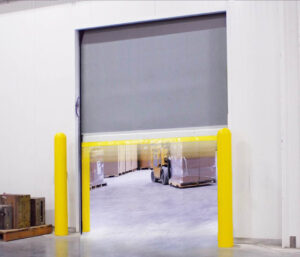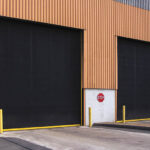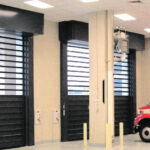FAQ: What is a High-Speed Door?
FAQ:
What is a high-speed door?
Answered by an Experienced Rytec Technical Expert
Randy Meyer
Technical Education Specialist with over 29 years of experience in the high-performance door industry

FAQ:
What is a high-speed door?Think of a high-speed door as the superhero of industrial doors — built to open and close at lightning speed while keeping your operations running smoothly. These doors aren’t just about going fast (though that’s a big part of it). They help maintain temperatures, improve safety, and keep your facility more efficient overall.
If you’ve ever waited for what feels like forever for a traditional door to open while forklifts line up behind you —you’ll appreciate what a high-speed door can do.
Key Features of High-Speed Doors
Fast Operation
We’re talking serious speed — high-speed doors open much faster than traditional doors—often 32 inches per second or more, with some models reaching speeds up to 60–100 inches per second. Less waiting means smoother traffic flow.
 Built for Frequent Use
Built for Frequent Use
These doors are made for the long haul — designed for millions of open/close cycles they work hard, day in and day out, with minimal maintenance and headaches.
Energy Efficient
Because they open and close so quickly, they help keep heat or cold in. That means your HVAC system doesn’t have to work overtime — and you see lower energy bills.
Improved Workflow
In a busy warehouse or production line, every second counts. High-speed doors keep things moving, whether it’s forklifts or people with products passing through. No more stop-and-go traffic at the door and no more bottlenecks.
Flexible Designs and Materials
Need to meet clean room compliance? Have limited space? What about hurricane-rated? There’s a door for that. High-speed doors come in all kinds of models, styles and materials — like fabric roll-up, metal rigid rolling and insulated sliding. It’s all about what your space needs.
 Safety-First Features
Safety-First Features
No one wants an “oops” moment with a fast-moving door. That’s why most models include soft edges, detection sensors, and warning lights to help protect both people and equipment.
Ideal for Industrial Environments
You’ll see these doors in industries like logistics, manufacturing, food processing, cold storage, parking and automotive dealerships. Basically, anywhere that needs to control the environment and keep things moving efficiently.
 Fabric vs. Rigid Rolling High-Speed Doors: What’s the Difference?
Fabric vs. Rigid Rolling High-Speed Doors: What’s the Difference?
The most obvious difference is security—rigid rolling doors offer greater protection compared to fabric doors. However, each type has its own strengths depending on the application. Let’s break it down:
Durability & Cycles
Fabric roll-up doors have fewer moving parts, which often translates to higher cycle capability and reduced maintenance. They’re the marathon runners of the door world.
Security & Construction
Rigid doors are built from solid slats and are better suited for applications requiring enhanced security or physical separation.
Counterbalance Systems
Rigid doors generally use spring packs (tension springs) to counterbalance the door’s weight. Fabric doors can go either way — some use counterweights for smoother operation, others use a direct-drive system that operates without counterweights.
Windows & Ventilation Options
Both door types can be customized with windows for visibility (even tinted options). Rigid doors can also include ventilated slats for airflow. Fabric doors can have windows or screen material to keep air moving.
Choosing the Right Door
Each door type has its own benefits — and the “right” one really depends on your facility environment, traffic patterns, and security requirements of what you’re trying to protect or control.
The best thing to do is contact us and speak with knowledgeable Rytec sales representative who can walk you through the options, check out your facility needs, and recommend a door that fits your operation like a glove.
Bottom Line:
High-speed doors are the unsung heroes of efficient facilities. They save time, energy, and maintenance headaches — and when chosen correctly, they make your day-to-day operations a whole lot smoother.




